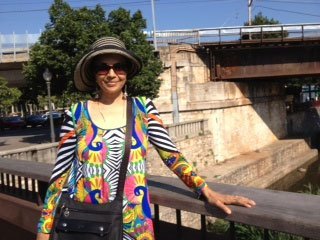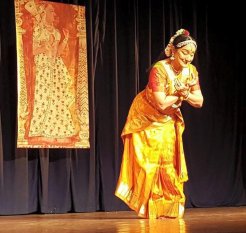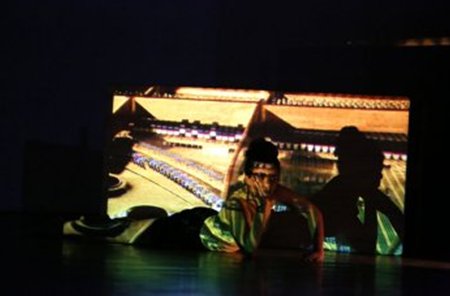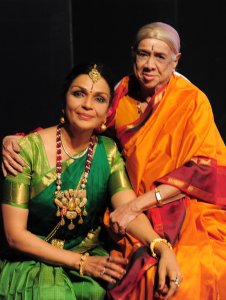
|   |

|   |
September 1, 2015  August is Madras month. It was 376 years ago on August 22 that the British leased a small strip of land from the Dutch on a date which is now widely marked as the birth of Madras - Madras Day. While the celebrations began in a modest way several years ago by a small group of citizens who wanted to revive the "idea" of Madras and its colourful history, the week has now grown to become an entire month filled with talks, heritage walks, and rare cuisine offerings, music, movies and even standup comedy! Theatres, cafes, art galleries, hotel lobbies, heritage buildings and private homes became venues for the month long celebrations. For a dancer, it was a dream month. A chance to watch the legends talk, share and perform. To watch practitioners in their seventies and beyond make us gasp and sigh in admiration! Two important dance events illuminated the month for me. Early in August was the presentation by Dr. Padma Subrahmanyam and her ensemble on the entire set of 108 karanas and her two creative interpretations of Japanese and Russian composers. To watch this amazing almost 75 year old on stage, still able to communicate and bring the audience to their feet in applause was in itself a tour de force. While we cannot expect the agility and suppleness Paddu Akka demonstrated in her thirties and forties, her younger protégés, Gayatri Kannan and her daughter Mahati Kannan proved to be able inheritors of the Bharata Nrityam parampara. Watching the karanas being performed also brought home the singular pedagogical systems that Padma has put into place to train her students limb by limb. She shared a sliver of the methodology with the audience at the end but there is much to learn from her physical training process when I watched the dancers lift their legs with ease almost up to their ears in a couple of instances. Padma herself transformed into the essence of liquid bhakti for her performance of ‘Gajendra Moksha.’ Moving to blind Japanese composer Miyagi's tune, she responded to each nuance and note of the music making it seem that it was written for her. Her innate musical connection and ability to respond to every microtone is what makes her performances truly "visual music." Late August marked Leela Samson’s 20th anniversary of her SPANDA Dance Company. Starting as an ensemble dance performance of the same name in New Delhi, SPANDA expanded to become more than a dance production. With many of her old students in attendance, the two day celebrations became a treasured experience for dancers and rasikas. Four senior performers were invited to share their memories and excerpts of teachings from their traditional gurus. The two day symposium was titled VARNAM and it was this single item that was the centre of discussion and exposition. Three of the four had direct links to the artistic community of musicians and dancers - Nandini Ramani (Balasaraswati), Sudharani Raghupathy (Kitappa Pillai) and Lakshmi Viswanathan (Elappa Pillai). The fourth performer was CV Chandrasekhar (Kalakshetra) whose alma mater had heralded sweeping changes to Bharatanatyam 70 years ago.  Lakshmi Viswanathan  Sudharani Raghupathy Music and musicality were the main issues that emerged in the shaping of the great dance teachers. Elappa Pillai, Kitappa Pillai and Balasaraswati were all great musicians. Dance and performance or teaching came later. Each of the three women invited us into remarkable anecdotes that opened the window into their learning. For Balasaraswati, the elaborations of nritta and a large variety of adavu patterns was not the mainstay of the dance form. Poetics and the flow of the verse/words/intention were more important. Nandini Ramani was precise and true to her training without flourishes or theatricality. Especially appealing was the way the hands knit the gestures together, one flowing into the other. She also continued to move and walk while emoting, something we don’t see any more on the concert stage. For Sudharani, the slow maturity into being asked to imagine Lord Siva and the majestic lingam was almost like a 10 year exercise that guru Kitappa Pillai gave her. “How would you do it?” would be the prompt. Watching Sudha in a stationary position suggest the giant lingam at Tanjavur and the explorations of decorating the stone monolith with reams of cloth and gallons of milk and curd was delightful. As was Lakshmi Viswanathan whose sharp wit and knowledge shone through in her talk and demonstration. Two superb varnams DAANIKE and VIRIBONI had the capacity audience in raptures. Rare adavus, and unusual choreography revealed the early imaginations of the traditional gurus. CV Chandrasekhar had the audience in stunned silence with his agility and stamina at age 82. While some in the audience were ready to swoon at his portrayal of a pining 'nayika', the majority of rasikas were in full praise of the three women and their moving portrayals. It was a moment when, as dancer Priya Murle declared, “Move over stars, the legends are here!” I did miss demonstrations of the Ramaiah Pillai and KJ Sarasa schools. The Vazhuvoor style is a crucial aspect of dance history. And Ramaiah Pillai was a pioneer in more ways than one! The ease, 'araam', 'amaidi' of classical dance up to the late 1970s and today’s complete absence of it was glaring. Perhaps it was in the early 1980s when Malavika Sarukkai and Alarmel Valli gained notice and success, that the new style of structuring and mapping out each line and swara and leaving nothing to imagination or ‘manodharma’ was established. We do not see today's classical dance stars pause, enjoy a flourish of the swara or take an extra moment to improvise on the spot. I had a discussion with Aniruddha Knight about this some time ago after watching him emote to his grandmother Balasaraswati's famous "Payyada" padam. Aniruddha danced, gestured, paused, took over from the singer and sang the lines beautifully before resuming the dance. This approach will now be considered almost strange with the new generation. So few of them know the music that they dance to! Watching the emerging star Shweta Prachande dance on the steps of a five star hotel the day after this historic seminar reminded me of how far Bharatanatyam has journeyed from an art form with deep resonances of poetic emotion to an overt show of lithe grace, and leaping kinetics. Mark my words - Shweta is a rising star and you will be hearing and seeing a lot of her in the coming years. However, for this performer and dance passionista - all this leaping and twirling, as a clone of her current guru Priyadarsini Govind - is pretty and remains just that. Not to mention the poor choice of two tillanas back to back for the impatient chatteratti! August was also a month of mourning and remembrance. On the 19th day of the month we marked the first anniversary of my Guru Adyar K Lakshman, whose legacy is being torn in the family tussle between daughter and daughter-in-law. On this same day this year, we lost Guru MV Narasimhachari to a heart attack. A blessed way to die but a shock to his family and students. On the very same day I was performing in Bombay to celebrate my first guru Rajee Narayan’s 85th birthday. Yes! A strange day when life reveals itself in all its multiple rasas! In the passing of natyacharyas Gopalakrishnan Pillai and Pandanallur Swaminatha Pillai, grandsons of Meenakshi Sundaram Pillai, the Pandanallur heritage has completely disappeared. A year ago we lost Guru Maya Rao in Bangalore. Mayaji was someone I truly adored - wise, sensitive and full of humour! Two months ago, Jayalakshmi Alwa and Shyamala Mohanraj breathed their last. In the passing of so many greats in the past two years, we have come face to face that our heritage is now in the hands of those fortunate men and women who were lucky to meet, learn and be tutored by great minds. How much we have lost by not honouring them in time, by not documenting their contributions and by not acknowledging their generosity! A majority is gone forever and we are the poorer for it! Amidst a month filled with such beautiful and passionate dancing, I managed to watch the final showing of the GATI summer contemporary dance showcase in New Delhi. 6 performers had spent 10 weeks under the watchful eyes of several dance and music mentors and created 10 minute sections. This was presented to a small invited audience. Team GATI has evolved into a smart and successful crucible for contemporary dance. But they were unable to lift the hour long showcase above the banal and derivative. Placing the dancers in the round was itself a daunting challenge. What I saw felt like an endless dirge of dull, listless and uninspired dance. Some looked like they had tumbled out of bed, others were totally out of shape. The two performers who "looked" physically fit delivered the weakest performances. 10 weeks working 5 days a week should be more than enough time to create longer and fuller work. I was disappointed and so were many in the audience. Contemporary solo artistes have a long and lonely struggle. In India, the classical dance hegemony will always exercise more heft and influence. Working ‘against’ narrative, myth and formal structure was one way of history’s engagement towards the creation of a modern dance movement. In India with myths being an integral part of everyday life and politics, the effort needs much more rigour and introspection.  In a country with so much colour, emotion and contrasts, I am still surprised when the current crop of ‘contemporary’ dancers in India seem defiant about embracing anything about their immediate surroundings, Instead most seem to want to be German, Belgian, Dutch or anything BUT Indian. Why be a pale imitation of someone else? Here one can argue about "what is truly Indian?" Perhaps this is the conundrum that also confronted talented performers Padmini Chettur, Preethi Athreya, Mandeep Raikhy and Navtej Johar who received lukewarm or poor audiences at the Singapore International Arts Festival. While Mandeep’s ensemble drew praise for its bold and confident semi clad body language, several audience members walked out of Padmini’s performance. Singapore audiences were obviously not ready to accept modern dance trends in India. Surrounded as they are by temples and historic diaspora culture, the Indian community in this island state is still drawn to the old world images of religion and the arts. Festival Artistic Director Ong Keng Sen has already created a three year programme for the festival and has been given the budget to commission a special 50 hour work on Indian nationalist Subhash Chandra Bose called GIVE ME YOUR BLOOD AND I WILL GIVE YOU YOUR FREEDOM. Singapore was where Bose travelled to recruit for his Indian National Army (INA). For this signature festival showpiece, Indian performance artist Nikhil Chopra will be inside a white box 20 metres by 12 metres. He will paint the entire area with a long black brush and will be brought food much like a monk in a monastery. I have been watching and following OKS and his work over the past 20 years and he has always amazed me. Popularly known as Asia’s Peter Brook for his expansive vision and ambitious plans for theatricality and stunning staging, this is the first time in Singapore's cultural history that a member of the arts community (and not a bureaucrat) is in charge of its annual arts festival. And OKS has very big plans to make Singapore, an economic and banking superpower that has poured millions into building theatres and funding local artistes, into Asia's epicentre for avant garde creativity. Wow! What a luxury to plan so far ahead! When the line up for the January 2016 dance festival at the Madras Music Academy is already put up on the organization’s website, we are all surprised! 4 months ahead! For India, this is a real feat! With so much information, technology and speed of communication available, it is possible for the December season to have its line up planned and released by mid July! Sabha secretaries listening?  Mid month found me in Bombay for a day to mark the 85th birthday of my first guru Rajee Narayan. Now a smiling 85 years and mobbed by friends, admirers and her international student group, I found myself with the distinct honour of being her oldest and first student. Celebrated and praised by senior gurus Kanak Rele, Darshana Jhaveri and Kalyanasundaram Pillai, Rajee Narayan absorbed the momentous occasion with great calm. What a turbulent life she has fought and triumphed against! How art has pulled her through! Back stage at the majestic Shanmukhananda Hall was sheer chaos. In a good way. Amidst chaat, vadai, upma, dokhla and hot chai, we laughed, caught up with our lives and took innumerable selfies! The actual performance was brief, each of us doing one of Rajee aunty’s songs. But the celebrations were unforgettable! Honorary Indian Ramli Ibrahim flew in for 48 hours to release his second book QUINTESSENTIAL SUTRA in Pondicherry and Madras. Beautifully produced as is his hallmark, Ramli was delighted when dance divas and other admirers attended and thronged around their favourite Odissi dancer. The book is not cheap and predictably, the sales were not encouraging. Dancers would rather be featured in books than buy them but this is a volume worth owning. Ramli now oversees the ambitious DIVERSECITY, where Malaysia as the featured ASEAN of 2015 will present 19 new productions in dance, theatre, music and ritual arts. Along with veteran critic Leela Venkataraman, I have been invited to watch and report on this ambitious month long arts carnival. Watch for the creative juices to run AMOK (a Malay word) all September! Reality TV has made every leisure activity into a competition. Cooking, running, walking, hiking, trekking… nothing is personal or sacred anymore. Everything is about who is the fastest, strongest, bravest and quickest. The popularity of dance shows where the best is awarded is also a case in point. Dancers of all ages train for that one 4 or 5 minute piece. Again and again. And the celebrity judges and audience votes for the favourite. In this compressed time machine, it is always the most exciting or thrilling group or soloist that wins. Where is the space and value for stillness and a deeper emotive content? None. And what about dancers’ health? With two of my high school classmates, both part time dancers, dropping dead of heart attacks last month, it has become a wakeup call to my entire graduating class. Do dancers actually go for the annual health check up? Do we think that dance will somehow banish all the health problems that afflict others? Dancers - men and women - don't take your lives and daily breath for granted. Get yourself checked out. NOW! Please! Between rehearsals and other speaking/writing engagements, I found myself dragged unwillingly to participate in a heritage fashion show ahead of the Global Investors Meet for Tamilnadu. If green rooms at sabhas were of poor standards, then the fashion show backstage was sheer chaos! Cigarette butts, semi nude models, hair extensions and make up all over the place, lingerie strewn everywhere.... Tsunami in a nutshell. I fled! Ran so fast that the organizers had to run faster to catch up to me and beg me to return to an exclusive dressing room. The entire event was fairly mediocre but meeting old friends made up for the negative experience. I was left wondering how the designers and their expensive bling laden clothes could be treated so carelessly by the models and how silk and gold clad classical dancers must feel when dressing rooms and toilets were unclean to spoil their pre-performance mood! For those reading this message on the first day of September, a large gathering of past and present Kalakshetra students will gather under the historic banyan tree to celebrate and remember the birth centenary of Periya Sarada teacher - Smt S. Sarada. A savant, scholar, musician, archivist, storyteller, Sanskritist, theosophist, life coach - Periya Sarada teacher was all this wrapped up in a slender frame of pure dynamic intelligence. To acknowledge her final days of solitude and sadness, banished from her beloved Kalakshetra during the Government takeover of the institution and forgotten by her students and admirers, is a statement of the selfish human condition. Ten years ago I was able to publish a book containing a collection of articles on her life and work. Editor Lalitha Venkat remembers the terrible rains and the flooded streets that hampered all activity in Chennai in December 2005. She had to wade through knee deep water to the printer and somehow get the first 100 copies hot off the press. Breathing over her shoulder was Sarada teacher’s caregiver G. Sundari. When the books came to our hands, Lalitha discovered 3 spelling errors. Manually she and another office colleague Kannan took white out liquid to make the corrections on all 1000 copies of NIRMALAM that is now out of print but the exercise of gathering the articles and editing them into a cohesive volume took a huge amount of work! And I developed a whole new appreciation of the gentle genius of Periya Sarada teacher! Ten years ago, the digital world had not closed in on us. We did not live through our hand helds and hit LIKE every five minutes on our Facebook pages. It is now official. In August 1 billion people visited Facebook and other online media. During my three hour session with young bloggers interested in gaining appreciation of the arts, three important avenues opened up as pathways for marketing the arts. Radio, Facebook and Whats App. Every participant confessed that they did not read the hard copies of national dailies and instead consume all information and news only from these three sources. Note to performers who want to broaden their audiences. Think out of the box! This month will find me once again in Bombay performing NEELAM, still in active repertoire after ten years. It was almost exactly a decade ago that I first performed it on Vaikunta Ekadasi day at Chennai’s Sri Krishna Gana Sabha. It was the first recorded score for dance by the now celebrated duo of Anil/Sikkil. While NEELAM has grown and travelled to many cities, I continue to introspect and find new spaces to explore within this four sectioned work. Thank you to all my imaginative and brilliant collaborators, Rex, Anil Srinivasan, Hari Krishnan, Sikkil Gurucharan and my female ancestors who gave me the historic references and opened the window to the world of ritual, rites and sacred geographies. I must mark the extraordinary effort of team NCPA led by Swapnokalpa Dasgupta, Benaifer Besunia and the Mumbai media to ensure that the numerous phone and print reports were accurate. What a pleasure to speak to intelligent women who are really keen to understand! Far better than present day Chennai media where one young 23 year old arts reporter could not get Padma Subrahmanyam and Lakshmi Viswanathan's names right! They became Padma Lakshmi and Lakshmi Venkatesh in print! As I sign off, I share a cracker of a video showing a fantastically upbeat choreography of a group called DESI HOPPERS. Watch how Bharatanatyam, Siva, Vishnu and other ideas get morphed into an entertaining piece created by an African choreographer! Enjoy! And in that upbeat spirit mark the start of the festival season! Ganesh, Devi, Krishna… all the Gods - human and divine - are upon us... including dancers who now feel compelled to announce themselves as ‘swamis’ and ‘swaminis’ and neo-devadasis! Enjoy the spirit, cherish the moment. Every moment is precious! In gratitude to gurus, ancestors and teachers… and all those who have paved the road for us to tread upon... - Dr Anita R Ratnam Mumbai/ Kuala Lumpur/ Chennai Twitter: @aratnam Facebook: Anita R Ratnam Instagram: @anitaratnam Blog: THE A LIST / anita-ratnam.blogspot.in Post your comments |